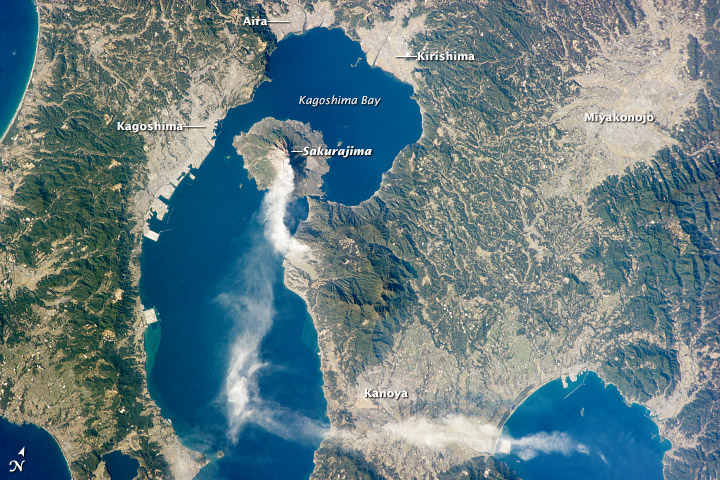Sakurajima Volcano, Kyushu, Japan
January 28, 2013

This photograph, taken from the International Space Station, highlights one of Japan's most active volcanoes. Sakurajima began forming approximately 13,000 years ago; prior to 1914, it was an island in Kagoshima Bay. Sakurajima was joined to the mainland by the deposition of volcanic material following a major eruption in 1914.
Several craters lie near the 1,117-meter summit of Sakurajima. The northernmost crater, Kita-dake, last erupted approximately 5,000 years ago; to the south, Minami-dake and Showa craters have been the site of frequent eruptions since at least the eighth century. The ash plume visible near the volcano's summit may have originated from either Minami-dake or Showa.
This image highlights the proximity of several large urban areas—Aira, Kagoshima, Kanoya, Kirishima, and Miyakonojo—to Sakurajima. This has prompted studies of potential health hazards presented by the volcanic ash (such as Hillman et al. 2012), and those findings are particularly important if more powerful explosive eruptive activity resumes. The Tokyo Volcanic Ash Advisory Center (VAAC) of the Japan Meteorological Agency issues advisories when eruptions occur. An advisory on the activity in this image was issued less than one hour before the astronaut took the photograph, by which time the plume tail had encountered northeast-trending upper-level winds.
Reference
- Hillman, S.E., Horwell, C.J., Densmore, A.L., Damby, D.E., Fubini, B., Ishimine, Y., and Tomatis, M. (2012) Sakurajima volcano: a physico-chemical study of the health consequences of long-term exposure to volcanic ash. Bulletin of Volcanology, 74:913–930.
Astronaut photograph ISS034-E-27139 was acquired on January 10, 2013, with a Nikon D3S digital camera using a 180 millimeter lens, and is provided by the ISS Crew Earth Observations experiment and Image Science & Analysis Laboratory, Johnson Space Center. The image was taken by the Expedition 34 crew. It has been cropped and enhanced to improve contrast, and lens artifacts have been removed. The International Space Station Program supports the laboratory as part of the ISS National Lab to help astronauts take pictures of Earth that will be of the greatest value to scientists and the public, and to make those images freely available on the Internet. Additional images taken by astronauts and cosmonauts can be viewed at the NASA/JSC Gateway to Astronaut Photography of Earth. Caption by William L. Stefanov, Jacobs/ESCG at NASA-JSC.
http://earthobservatory.nasa.gov/IOTD/view.php?id=80274&src=ve
--
Zenguins!
Vei8-Volcanoes of the World Webcams
Roxxfoxx~~Adventures in Geology
Penguin News Today
Penguinology: The Science of Penguins
Gentoo Penguins of Gars O'Higgins Station, Antarctica
Canis lupus 101
Dances with Werewolves
Through Golden Eyes
Follow me on Pinterest!
__._,_.___
No comments:
Post a Comment